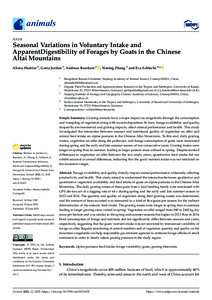Seasonal Variations in Voluntary Intake and ApparentDigestibility of Forages by Goats in the Chinese Altai Mountains
| dc.date.accessioned | 2022-08-15T10:02:58Z | |
| dc.date.available | 2022-08-15T10:02:58Z | |
| dc.date.issued | 2022-06-27 | |
| dc.identifier | doi:10.17170/kobra-202208126621 | |
| dc.identifier.uri | http://hdl.handle.net/123456789/14056 | |
| dc.description.sponsorship | Gefördert durch den Publikationsfond der Universität Kassel | ger |
| dc.language.iso | eng | |
| dc.rights | Namensnennung 4.0 International | * |
| dc.rights.uri | http://creativecommons.org/licenses/by/4.0/ | * |
| dc.subject | alpine pastures | eng |
| dc.subject | feed intake | eng |
| dc.subject | forage variability | eng |
| dc.subject | goats | eng |
| dc.subject | grazing itineraries | eng |
| dc.subject.ddc | 590 | |
| dc.subject.ddc | 630 | |
| dc.title | Seasonal Variations in Voluntary Intake and ApparentDigestibility of Forages by Goats in the Chinese Altai Mountains | eng |
| dc.type | Aufsatz | |
| dcterms.abstract | Forage availability and quality directly impact animal performance, ultimately affecting productivity and health. This study aimed to understand the interaction between qualitative and quantitative vegetation availability and feed intake of goats on alpine pastures in the Chinese Altai Mountains. The daily grazing routes of three goats from a local herding family were monitored with GPS devices set at a logging rate of 64 s during spring and the early and late summer season in 2013 and 2014. The quantity and quality of vegetation along their grazing routes was determined, and the amount of feces excreted was measured in a total of five goats per season for the indirect determination of the animals’ feed intake. The grazing routes were longer in spring than in summer, leading to larger grazing areas visited in spring. Vegetation on offer ranged from 980 to 2400 kg dry mass per hectare and was similar in the spring and summer seasons but higher in 2013 than in 2014. Feed consumption of forage and nutrients did not significantly differ between seasons and years, respectively, suggesting that the goats’ nutrient intake was not restricted by interannual variability of forage on offer. Regular monitoring of animal numbers and of vegetation quantity and quality on the mountain rangelands can help responsible government agencies to estimate forage offtake of small ruminants in order to timely adjust grazing pressure in the study region. | eng |
| dcterms.accessRights | open access | |
| dcterms.creator | Shabier, Alimu | |
| dcterms.creator | Jordan, Greta | |
| dcterms.creator | Buerkert, Andreas | |
| dcterms.creator | Zhang, Ximing | |
| dcterms.creator | Schlecht, Eva | |
| dc.relation.doi | doi:10.3390/ani12131652 | |
| dc.subject.swd | Altai | ger |
| dc.subject.swd | China | ger |
| dc.subject.swd | Mongolei | ger |
| dc.subject.swd | Weide <Landwirtschaft> | ger |
| dc.subject.swd | Futteraufnahme | ger |
| dc.subject.swd | Futtermittel | ger |
| dc.subject.swd | Exkrement | ger |
| dc.subject.swd | Tiergesundheit | ger |
| dc.subject.swd | Vegetation | ger |
| dc.subject.swd | Wiederkäuer | ger |
| dc.subject.swd | Nachhaltigkeit | ger |
| dc.subject.swd | Viehwirtschaft | ger |
| dc.type.version | publishedVersion | |
| dcterms.source.identifier | eissn:2076-2615 | |
| dcterms.source.issue | Issue 13 | |
| dcterms.source.journal | Animals | eng |
| dcterms.source.volume | Volume 12 | |
| kup.iskup | false | |
| dcterms.source.articlenumber | 1652 |
Dateien zu dieser Ressource
Das Dokument erscheint in:
-
Artikel [1186]


